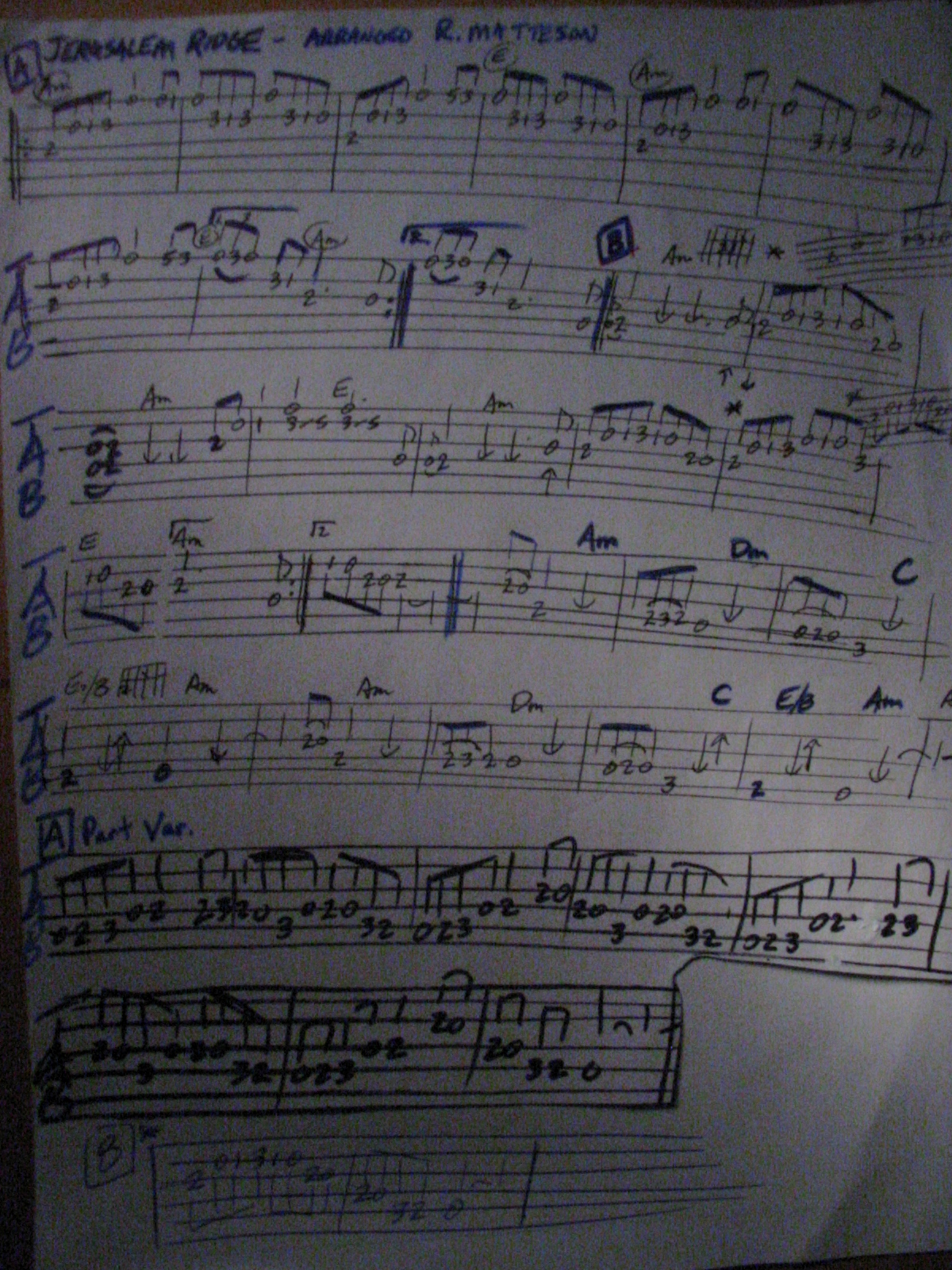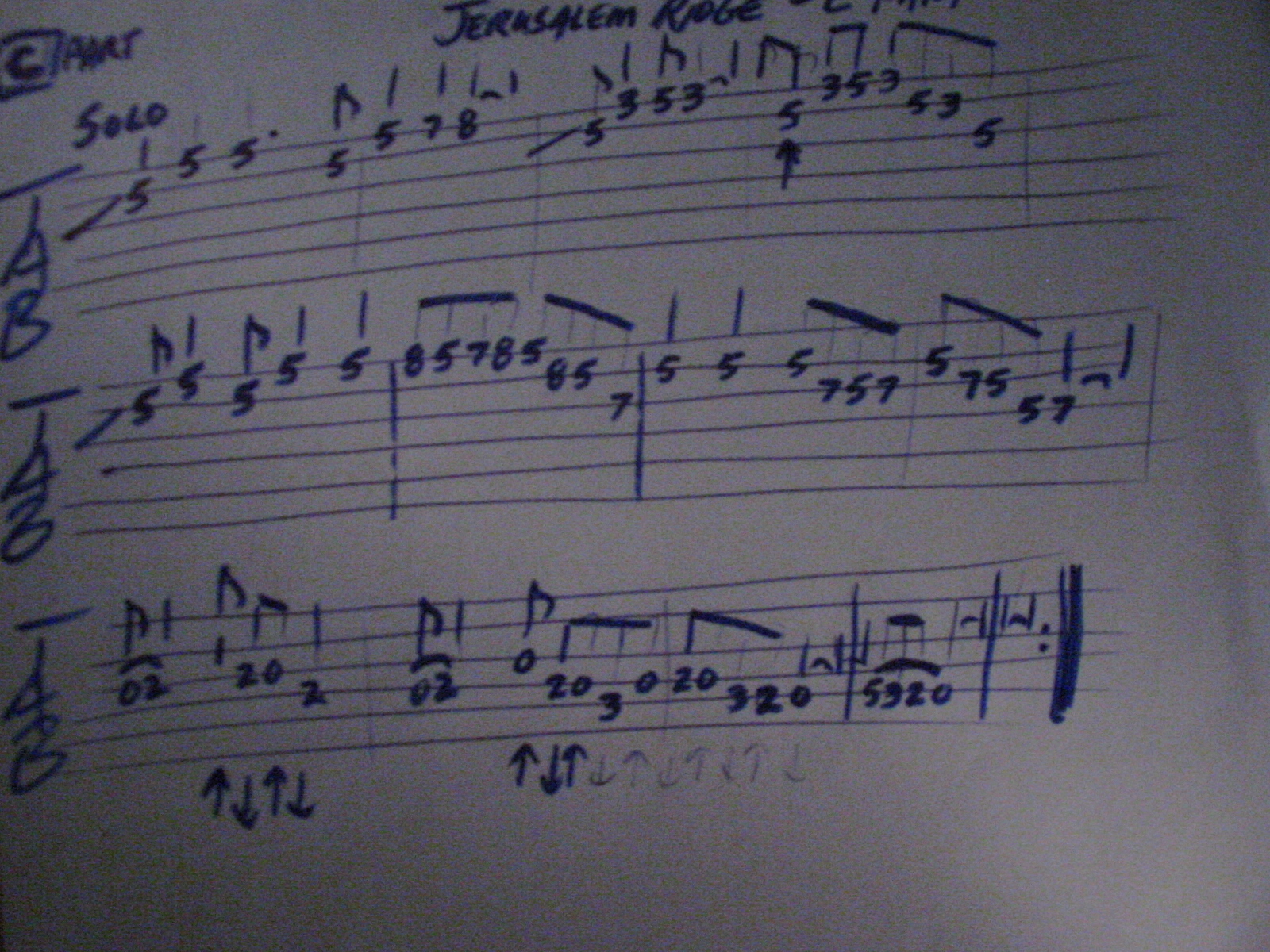|
Glory To the Meeting House/Jerusalem Ridge
Old-time (Glory to the Meeting House) and Bluegrass (Jerusalem Ridge) breakdown, widely known. Lyrics and melody composed by Richard L. Matteson Jr. 2009 based on the fiddle tune, Jerusalem Ridge.
ARTIST: Richard Matteson (guitar) with his niece Kara (vocals). Demo of Glory To The Meeting House MP3 done Dec. 2009.
CATEGORY: Fiddle and Instrumental Tunes; DATE: Glory to the Meeting House 1800’s. Jerusalem Ridge 1974 arranged/composed by Bill Monroe and Kenny Baker; New melody and lyrics 2009 Richard Matteson
RECORDING INFO JERUSALEM RIDGE: Jerusalem Ridge - Bill Monroe/Kenny Baker
Banjo Newsletter, BNL, Ser (1973-), 1976/05,p18
Baker, Kenny. Kenny Baker Plays Bill Monroe, County 761, LP (1976), trk# 4
Baker, Kenny. Brody, David (ed.) / Fiddler's Fakebook, Oak, Sof (1983), p147
Black, Bob. Ladies on the Steamboat, Ridge Runner RRR 0018, LP (1979), trk# A.03
Blake, Norman. Blackberry Blossom, Flying Fish FF 047, LP (1977), trk# B.05
Brown, Alison; and Stuart Duncan. Pre-Sequel, Ridge Runner RRR 0030, LP (1981), trk# B.02
Bulla Family. Family Fiddlin', Family Vision Ministries, Cas (1989), trk# A.05
Burke, Kevin. Up Close, Green Linnet SIF 1052, LP (1984), trk# A.05b
Conroy, Mike. Montana Mountain Fiddle, Alpha 08361, LP (198?), trk# B.02
Gold Rush. First Strike, Gold Rush GRR 1000, LP (1981), trk# A.03
Mabus, Joel. Fairies and Fools, Flying Fish FF 296, LP (1983), trk# 5 (Planxty William Monroe)
MacKenzie, Tom. Finally Tuned, Rooster 104, LP (1980), trk# 12
Pedi, Don. Mountain Magic, Badger Bgr 1003, Cas (1990), trk# A.01
Robins, Butch. Fifth Child, Rounder 0130, LP (1980), trk# 3
Taylor, Hollis. Twisted Fiddle, Gleeful GL 003, CD (1991), trk# 4
Wood, Jim. Devil's Box, Devil's Box, Ser, 32/4, p21(1998)
RECORDING INFO Glory in the Meeting House
Bartlett, Sam; and Jamie Gans. Blue Earth, Yodel-Ay-Hee 013, Cas (1994), trk# 9
Bunkhouse Orchestra. Old-Time Cowboy Songs, Gibbs Smith, Cas, trk# 10
Cravens, Red; and the Bray Brothers. 419 West Main, Rounder 0015, CD/ (1972), trk# 3
Fiddle Tune
Burke, Kevin. Open House, Green Linnet GLCD 1122, CD (1992), trk# 8
Gellert, Dan; and Shoofly. Forked Deer, Marimac 9000, Cas (1986), trk# A.08
Hurricane Ridgerunners. Young Fogies, Heritage (Galax) 056, LP (198?), trk# 33
Milnes, Gerry; and Lorraine Lee Hammond. Hell Up Coal Holler, Shanachie 6040, CD (1999), trk# 6
Strong, Luther. Titon, Jeff Todd / Old Time Kentucky Fiddle Tunes, Kentucky, Bk/ (2001), p 80/# 49 [1937/10/18]
Strong, Luther. Fiddler Magazine, Fiddler Mag., Ser, 14/4, p43(2007) [1937]
Glory at the Meeting House
Furtado, Tony. Swamped, Rounder 0277, LP (1990), trk# 3
Harmony Sisters. Second Helping, Flying Fish FF 283, LP (1983), trk# B.04
Strong, Luther. Anglo-American Shanties, Lyric Songs, Dance Tunes & Spirituals, Library of Congress AFS L 2, LP (195?), trk# B.03 [1937]
OTHER NAMES: Glory In the Meeting House; Jerusalem Ridge; Glory At the Meeting House
RELATED TO: Glory In the Meeting House; Jerusalem Ridge
SOURCES: Kuntz; Folk Index
NOTES: Lyrics and new melody composed by Richard L. Matteson in 2009. Based on Jerusalem Ridge, a fiddle and instrumental tune written by Bill Monroe and Kenny Baker. Monroe and Baker probably used the old fiddle tune Glory in The Meeting House as the basis for their composition in circa 1974. Jerusalem Ridge is a ridge close to Monroe's childhood home in Kentucky.
The A and B parts by Monroe/Baker closely resemble versions of the old fiddle tune, "Glory in The Meeting House" which was performed at a fiddle contest in Berea, KY by Bev Baker as early as 1919. Bev Baker's version can be heard on-line at the Roots Music Listening Room along with Luther Strong's influential recording: http://www.juneberry78s.com/sounds/ListenToLutherStrong.htm
YouTube: Richard Matteson solo guitar arrangement TAB: Top part A is the fiddle range notes; The bottom part A is the low guitar part. Teh fill for B is at the very bottom.
View on You Tube: http://www.youtube.com/watch?v=6YNV566D5z8

TAB: C part- higher solo

Notes on Glory To The Meeting House: (Kuntz) Old‑Time, Breakdown. USA; Mt. Airy, N.C., Ky. D Mixolydian (Carlin/Sing Out): E Major/Mixolydian (Phillips): E Mixolydian/Dorian (Titon/Strong). Standard, EDae or ADad tunings. AABB'BB'C (Carlin/Sing Out): AA'BB'AA'B"B"' (Phillips): ABABACB’ABABA (Titon/Strong). Jeff Titon (2001) gives its provenance as the Kentucky River basin. The melody was in the repertoires of Kentucky fiddlers Luther Strong and W.H. (Bill) Stepp. It was also collected from fiddlers Bev Baker (Luther Strong’s father-in-law) and Boyd Asher, from the same region. The EDae tuning appears to have been generally applied to the tune in the region. Strong (like Baker and Asher) recorded his version for Alan Lomax and the Library of Congress in 1937, a trip which resulted in several eastern Kentucky fiddler’s waxing their renditions (on aluminium disks!) of this tune for the musicologist. The piece is heard played either in the major or mixolydian mode, and Titon says that Strong’s version has a dorian character. His version has been so influential, that dorian versions among modern fiddlers are prominent (Jody Stecher gives a considered musical analysis in his Fiddler Magazine article). Kentucky fiddler Hiram Stamper recorded a ‘crooked’ version in the key of D minor, with three parts, and other regional fiddlers also had ‘crooked’ versions—in fact, Strong’s version is the only older one to be ‘foursquare’. These older versions started with one of the high parts first.
Despite what might be inferred from the title, the tune apparently has no connections with hymnody, although Titon says “the C and B’ parts suggest the excitement of ‘shouting’ (getting happy, feeling the Spirit) in a church.” According to musicologist Jeff Titon, Stamper told Bruce Greene that "Glory in the Meetinghouse" was a contest tune that he originally learned from Bev Baker, a notorious figure but an influential fiddler. Stamper also indicated the tune was known to other fiddlers at the time and that Baker had played it in the 1919 Berea fiddle contest. Luther Strong says, “I won $500 on this tune” at the end of his LC AFS field recording. The tune has similarities to the bluegrass composition “Jerusalem Ridge.” Sources for notated versions: Luther Strong (Hazard, Perry County, Ky.) [Titon]; Mark Graham (Seatle, Wash.) [Carlin/Sing Out]; Armin Barnett with the Hurricane Ridgerunners [Phillips]; Luther Strong via Jody Stecher [Fiddler Magazine]. Sing Out! ("Teach In: Clawhammer Banjo," Bob Carlin).
Notes on Jerusalem Ridge: (Kuntz) Composed by bluegrass mandolinist Bill Monroe (Ky). Jerusalem Ridge is an area in the hills around Monroe’s birthplace near Rosine, Kentucky. His Uncle Pen Vandiver used to play his fiddle late into the evening up on Jerusalem Ridge. The tune has similarities to “Glory in the Meeting House,” an old fiddle tune collected from several eastern Kentucky sources, which may be a model or precursor. It is possible it influenced Monroe and/or Baker. Baker, however, was careful to give credit to Monroe for the composition. According to him, the band was staying in a motel in Kentucky back in the early to mid 1970s, when Monroe invited Baker to come to his room to work on a tune that Monroe was trying to fashion. The mandolinist would play a section and then would ask the fiddler to play it back, and then modify it. This process took some time, but in the end “Jerusalem Ridge” emerged.
Notes on Kenny Baker: Kenneth Clayton "Kenny" Baker (Born June 26, 1926, Burdine, Kentucky)
This instrumental was written in the early 1970's as a showpiece for Kenny Baker who was the fiddle player in the Monroe band at that time. The tune is named for a ridge near Monroe's home town of Rosine. It was first recorded by Monroe in March 1975.
Bill Monroe enjoyed Baker's work with Gibson and offered him a job should he ever need one. Baker joined the Blue Grass Boys for the first time in 1957, recording the classics "Panhandle Country" and "Scotland." When he came back in 1962, he sang baritone on the gospel album, I Saw the Light and was featured fiddler on tunes such as "Big Sandy River," "Baker's Breakdown," "Shenandoah Breakdown," and "Santa Claus." Leaving the mines after his two sons were grown, Baker rejoined the Blue Grass Boys and accompanied Bill Monroe on almost every recording he made (an astounding 237 cuts), from November, 1968 to December, 1983.
In the fall of 1984, his brother in the hospital, Kenny was miffed when Bill neglected his request for a touring schedule. On October 12, he walked off the stage permanently after Bill instructed him to play "Jerusalem Ridge" in response to a loud and drunken audience member's request. In 1994, near the end of Bill's life, intermediaries arranged a meeting of reconciliation and an onstage reunion at the Bean Blossom, Indiana festival.
LYRICS:
Glory To The Meeting House by Richard Matteson C 2009
based on Jerusalem Ridge/Glory To The Meeting House. Richard Matteson (guitar) with his niece Kara (vocals). Demo of Glory To The Meeting House MP3 done Dec. 2009.
VERSE:
[Am] Praise to God and sing,
Glory to the meeting house.
[Am] Praise to God and sing,
Halle [E]lujah to the Lord.
[Am] Let the fiddle ring,
Glory to the meeting house.
[Am] Let the fiddle ring,
With our [E]instruments of [Am] praise. (Repeat VERSE)
BRIDGE
[Am] Shout to God, glory hallelujah
Shout to God, in heav'n [E] a-bove.
[Am] Shout to God, glory hallelujah
Glory to the meeting house, of the [E]Saviour's [Am]love. (Repeat Bridge)
In the [Am] meeting [Dm] house, high [C]o'er Je [E/B]rusalem [Am] Ridge
In the [Am] meeting [Dm] house, high [C]o'er Je [E/B]rusalem [Am] Ridge.
CHORUS
[Am] Come hear the choir on Jerusalem Ridge,
[C] Sing loud and strong, and lift their voices higher.
[Am] When we climb Jordan's distant shore we're going to,
[Am] Sing hallelujah and [E] toil no [Am]more.
Hallelujah, hallelujah and [E]toil no [Am]more...no more. (Repeat Chorus)
Repeat from beginning (optional)
|